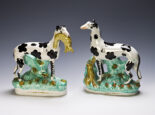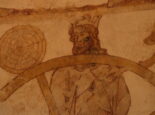Beautiful Burghley

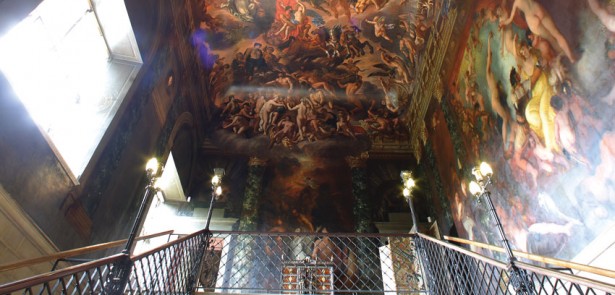
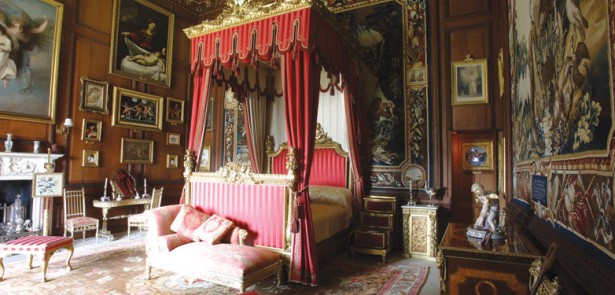
RICHARD GUNN visits Burghley House near Stamford, probably the finest of England’s surviving Elizabethan houses, and tells its history as well as meets the people who look after it today
 Something rather special happens during The Moment’s interview with Jon Culverhouse, the curator of Burghley House and the man who keeps an exhaustive encyclopaedia about this sprawling Elizabethan mansion in his head. A tentative knock at his office door is followed by two senior citizens entering, in a rather reverential manner as if somewhat in awe of this forbidden glimpse into the inner sanctum of one of England’s most majestic stately homes. It turns out they’re local, but often visit the house and its grounds, and the lady has found some old photographs, the property of a relative.
Something rather special happens during The Moment’s interview with Jon Culverhouse, the curator of Burghley House and the man who keeps an exhaustive encyclopaedia about this sprawling Elizabethan mansion in his head. A tentative knock at his office door is followed by two senior citizens entering, in a rather reverential manner as if somewhat in awe of this forbidden glimpse into the inner sanctum of one of England’s most majestic stately homes. It turns out they’re local, but often visit the house and its grounds, and the lady has found some old photographs, the property of a relative.
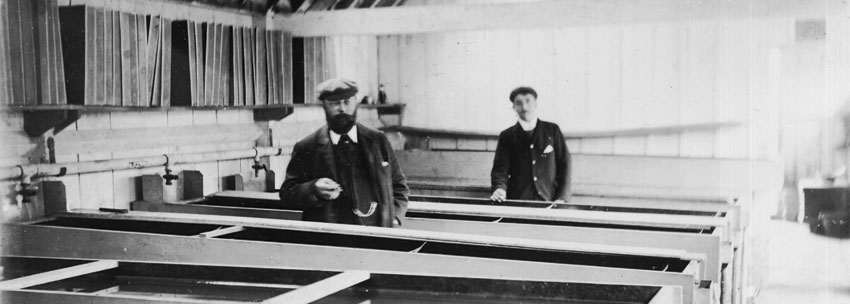
The old photograph of the trout hatchery, brought in during The Moment’s visit
Jon is fascinated. So is The Moment. The pictures seem to come from the late-Victorian era through to the 1920s, and are an intriguing snapshot – literally – of life a century ago on the Burghley estate. One image in particular captures Jon’s eye. It shows what he recognises as the trout hatchery, a building long since disappeared. And, despite working at Burghley for 25 years, he’s never ever seen another photo of it. He’s delighted, even more so when the couple say that he’s welcome to keep the pictures. They’re equally pleased when, as thanks, he arranges for a free tour of the house. “I learn something new every week, if not every day,” he says after they’ve gone. “This house just keeps on giving all the time.”
This sort of thing happens frequently at Burghley House. It’s been at the centre of Stamford life for over half a millennium and thus is held in great regard and affection by the people of the town. Even though, and whisper it softly, the border between Lincolnshire and Cambridgeshire runs through its ground, so the house itself is actually in Cambridgeshire and part of the Soke of Peterborough. But that’s just a line on a map really; for locals, Burghley is and always will be an intrinsic part of Stamford’s fabric.
And Jon is now an intrinsic part of Burghley’s fabric too. He came here a quarter of a century ago and, as curator, is responsible for the upkeep, maintenance and repair of the house’s collection. “This kind of job is a lifetime; it’s pretty special. There are quite a few areas of the house I’ve now seen redecorated twice,” he says. “You never get to the end. As with anything like this, you lift a floorboard here, take a panel off there, and it reveals a can of worms.
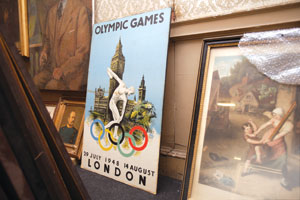 “There are thousands and thousands of different items here, and all the research and records of those objects. It’s an endless discovery. Plus there are enquiries the whole time. People show a great interest in places like this.”
“There are thousands and thousands of different items here, and all the research and records of those objects. It’s an endless discovery. Plus there are enquiries the whole time. People show a great interest in places like this.”
In fact, many tens of thousands of people ‘show an interest’ by visiting this amazing slice of Elizabethan architecture and its surrounding gardens each year, attracted not just by the house itself, but also by the opening of the historic Brewhouse in 2006 as an education, visitor and exhibition centre and the Garden of Surprises in 2007. Burghley’s screen appearances have also lured intrigued visitors; it has featured in Elizabeth: The Golden Age, The Da Vinci Code and the Keira Knightley version of Pride and Prejudice at the cinema, while on television it has featured in Climbing Great Buildings – during which Dr Jonathan Foyle clambered all over the house – and Royal Upstairs Downstairs. It takes a staff of around 60 people to look after the estate during off-season, but when the house is open to the public, this increases to about 90.
Open and free
Not all who come to Burghley pay for admission to come to the house and its formal gardens though, for the extensive pastoral parklands surrounding them are completely free to wander in, a situation not found at many stately homes. “The park has always been a very important part of Stamford and open to the people of the town,” says Jon. They can walk, laze, picnic and bring dogs in, although they have to be kept on their leads for the safety of the fallow deer that have roamed the area since the 1560s. “There may be a physical wall around Burghley but, to my mind, it isn’t there at all,” clarifies Miranda Rock, the House Director, appointed by the Burghley House preservation trust. She also lives at Burghley and is a member of the family for which the house was built. Which is something else perhaps a little unusual for a trust-administered stately home; that it has been continuously lived in by the descendants of its builder for over 500 years and remains a nest to this day. Beyond the history, there is a family home, inhabited by adults and children.
A building as magnificent and aristocratic as Burghley House could only have come from the inspiration – and fortune – of one of history’s great characters, and William Cecil was just that. Arguably, the most important figure in Elizabethan English politics behind the Queen herself, he served as her chief advisor and also held the positions of Secretary of State, Lord High Treasurer and the Lord Privy Seal. He was born in 1520 in Bourne, Lincolnshire, not far from Stamford where the family held the Burghley estate. William’s more highborn opponents would later disparagingly refer to his grandfather as keeping ‘the best inn in Stamford.’
William was elected to parliament representing Stamford in 1543, and soon rose through the political ranks. However, it wasn’t completely meteorically, for in late 1549, he was imprisoned in the Tower of London for his association with the out-of-favour Edward Seymour, the Duke of Somerset. It seems that William sweet-talked his way out of incarceration and within a surprisingly brief time was appointed a Secretary of State to King Edward VI.
His role as the administrator of the lands of the young Princess Elizabeth stood him in good stead when she ascended the throne in 1558. The Queen respected and trusted him, and he was undoubtedly regarded as her most vital minister. This allowed him to navigate the usually choppy waters of the Royal Court more successfully than most, surviving the rumours, suspicions, gossip and lies that saw many others incarcerated or executed. On the way, he amassed a considerable fortune as well as titles, Elizabeth elevating him to Lord Burghley in 1571.
A man of such state significance needed a suitable residence to reflect that and although he had places in London, a 1561 diary entry in which he referred to the imposing three-storey and turreted Cecil House in the Strand as ‘my rude new cottage’ suggests he felt something a little grander was in order.
The birth of Burghley
In fact, something a little grander was already underway up in Stamford. The first part of Burghley House, the east range, was constructed in 1555. The south side was erected in 1564, but then William got distracted by building another ‘prodigy’ mansion, Theobalds, in Hertfordshire, that would eventually grow to three times the size of Burghley. Work at the more northerly residence stalled until 1575. After it restarted, the gatehouse was completed in 1577, and the north front finished by 1587. William himself is credited as the architect, and the building was conceived as a giant ‘E’ shape, in tribute to Queen Elizabeth, although later alterations have now changed this layout. Further modifications to the structure in William’s lifetime (he died in 1598) included enlarging the Great Hall and adding the distinctive one-handed clock and obelisk overlooking the inner courtyard.
The building was conceived as a giant ‘E’ shape in tribute to Queen Elizabeth I
Despite being built partly in celebration of Queen Elizabeth, Her Majesty never actually visited Burghley. She’d made it as far as Stamford when Anne, William Cecil’s daughter, contracted smallpox, so she stayed at a nearby priory instead. It’s tempting to believe that she was at least able to view from a distance the glorious new mansion that served as a family home to her favourite statesman. There is a Queen Elizabeth’s bedroom at the house, with furnishings and décor definitely fit for a monarch, but most of the fittings date from the 17th century, well after the death of Elizabeth.
Oliver Cromwell and his troops had little respect for the house during the English Civil War; they bombarded, then stormed and occupied it. Subsequent inhabitants were more sympathetic though. The fifth Earl of Exeter (1648 to 1700) added imposing windows, an enhanced entrance at the south and the golden gates that now decorate the west front. His great-grandson, the ninth Earl, went even further, calling in the legendary Lancelot ‘Capability’ Brown to do considerable remodelling work on the then-200-year old house as well as landscape the park and gardens. Brown also oversaw the construction of the stable courtyard, Orangery and Lion Bridge although also demolished a north west wing to improve the view. One of the final major additions was that of a two-storey corridor around the inner courtyard, in 1828, under the second Marquess of Exeter (1795 to 1867). He managed what the original Lord Burghley couldn’t achieve and brought an English Queen to stay at the house; in this case Victoria. Twice. She visited as Princess Victoria in 1835, and then again in 1844, with her husband Albert. ‘I remembered its beautiful exterior and splendid situation but was even more struck when I arrived this time,’ recorded the Queen in her diary. The official reason for the visit was for the christening of one of the Marquess’ children, patriotically named Victoria; Albert was Godfather. But the trip had been four years in planning, the house had been extensively redecorated for the occasion, and “lots of houses and hotels were hired in Stamford for her retinue,” says Jon. “Half the Metropolitan Police force also came up as protection.” But amid this explosion of visitors, there was also time for the Royal couple to get away from it all. They hadn’t been married that long and apparently proved quite reluctant to emerge from their luxurious bedchamber (the Second George Room) each morning…
A century later though, and Burghley might have had a considerably less welcome guest, had the Second World War gone differently. Hermann Goering, the Commander-in-Chief of the Luftwaffe, had brought the Kaiser’s son to the area to study before war broke out. He was especially taken by the house and its art, and earmarked it as his personal residence had Germany invaded. Rumours were rife during the conflict that Goering had promised a court-martial to any air crew who hit the house, and this is thought to be one of the main reasons why Stamford escaped any significant bombing, despite RAF Wittering being just a stone’s throw away. However, there was a very near miss, according to Jon. “In September 1940, a German plane offloaded a bomb over Burghley on its way home. It fell 400 yards from the house and blew out all the windows on the west front.” Damage to nearby trees can still be seen and a fragment of the bomb is on display at the main entrance. If Goering ever found out about the incident involving his future holiday home and carried out his threat with the crew is lost to history.
During the 20th century, many large estates were broken up to pay death duties, often with the stately homes themselves ending up as National Trust property. The sixth Marquess, Miranda Rock’s grandfather, foresaw this happening to Burghley House and took steps to secure the future of the estate and ensure that the house remained what it was built to be and has always been; a family home for the descendants of William Cecil, with its collections intact. The Burghley House Preservation Trust Limited was established in 1969 as a charity to preserve and conserve the house for the nation. All profits go back into looking after the estate.
Visiting the house
Visitors to Burghley House are greeted in most rooms by knowledgeable and friendly guides; this isn’t a building where you just wander around aimlessly, unsure of what you’re looking at with nobody to ask for further information, or simply read dry information from noticeboards. The Moment’s tour is a little advantaged however, as it’s accompanied by Ruth Hudson, the operations manager and Carolyn Crookall, the assistant curator, who will take us to places not on the public itinerary. As Carolyn moves from room to room, she puts out estate-grown flowers. “It helps create an atmosphere of intimacy,” she explains. “Flowers help demystify a room, people can identify with them.”
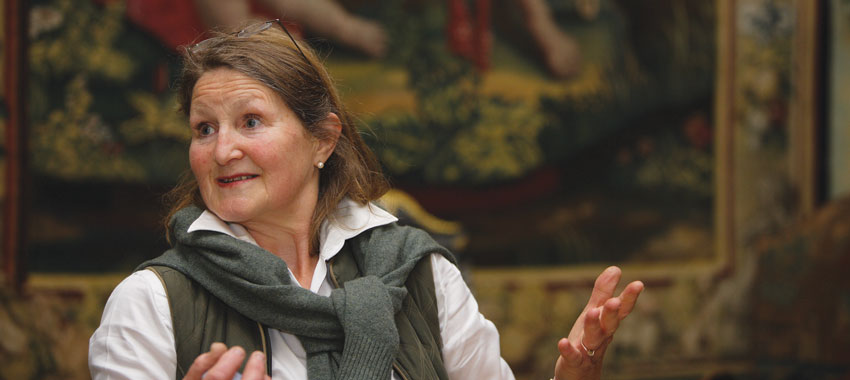
Carolyn Crookall, assistant curator
One of the great glories of the house is that there is a harmony throughout
From the start, it becomes clear that the grandeur of the exterior is matched by an equally amazing interior. The second room in is the old kitchen, almost cathedral-like in its proportions, with a high rib-vaulted roof tapering up to a chimney to extract smoke and fumes from the original fire. This aperture was only uncovered again in 1985, after being hidden within the bathroom of a second floor guest bedroom. Now though, the kitchen is as William Cecil would have known it, albeit weathered with centuries of smoke.
Many of Burghley House’s interior doors are like entrances to secret passages
 It’s when you move upstairs, via the rather dark and forbidding Roman Staircase to the State Rooms, that another important aspect of the house grabs the attention. The fifth and ninth Earls of Exeter (John and Brownlow, respectively) were keen collectors, journeying extensively through Europe, particularly Italy, on grand tours and bringing back paintings, tapestries, statues and furniture. John was so often abroad that he became known as the Travelling Earl, but his obsession with accumulating items to decorate the family home ran up enormous debts that were only paid off properly some 50 years later after fortuitous marriages brought in some much-needed readies to the estate. The result of these acquisitions is almost a visual overdose, with lavishly-decorated rooms that genuinely take the breath away. The flamboyance and decadence is almost overpowering to modern eyes, but such opulence and extravaganza was the fashion during the 17th and 18th centuries. “One of the great glories of the house is that there is a harmony throughout,” muses Carolyn. However, even so, the final rooms still come as a surprise, practically a shock. The Heaven Room contains a huge three-dimensional effect mural covering the entire interior space, and has been described as the greatest masterpiece of its creator, the 17th century Italian Baroque artist Antonio Verrio. It portrays scenes from ancient mythology, of ‘Gods and Goddesses disporting themselves as Gods and Goddesses are wont to do,’ as a Victorian guide book put it. Its complete contrast, also by Verrio and his last commission at Burghley, is next door. The Hell Staircase, descending to the Great Hall, is enclosed by a vista of the mouth of Hell, with tormented souls, the Grim Reaper and other representations of darkness and despair. It is bleak and sinister, but total genius. Curiously, one of female figures seems to be wearing thoroughly modern knee stockings. Actually, she’s just been partially left unrestored, following cleaning in 1993, to show how badly soot and dirt had affected the finish. Keep an eye out for her.
It’s when you move upstairs, via the rather dark and forbidding Roman Staircase to the State Rooms, that another important aspect of the house grabs the attention. The fifth and ninth Earls of Exeter (John and Brownlow, respectively) were keen collectors, journeying extensively through Europe, particularly Italy, on grand tours and bringing back paintings, tapestries, statues and furniture. John was so often abroad that he became known as the Travelling Earl, but his obsession with accumulating items to decorate the family home ran up enormous debts that were only paid off properly some 50 years later after fortuitous marriages brought in some much-needed readies to the estate. The result of these acquisitions is almost a visual overdose, with lavishly-decorated rooms that genuinely take the breath away. The flamboyance and decadence is almost overpowering to modern eyes, but such opulence and extravaganza was the fashion during the 17th and 18th centuries. “One of the great glories of the house is that there is a harmony throughout,” muses Carolyn. However, even so, the final rooms still come as a surprise, practically a shock. The Heaven Room contains a huge three-dimensional effect mural covering the entire interior space, and has been described as the greatest masterpiece of its creator, the 17th century Italian Baroque artist Antonio Verrio. It portrays scenes from ancient mythology, of ‘Gods and Goddesses disporting themselves as Gods and Goddesses are wont to do,’ as a Victorian guide book put it. Its complete contrast, also by Verrio and his last commission at Burghley, is next door. The Hell Staircase, descending to the Great Hall, is enclosed by a vista of the mouth of Hell, with tormented souls, the Grim Reaper and other representations of darkness and despair. It is bleak and sinister, but total genius. Curiously, one of female figures seems to be wearing thoroughly modern knee stockings. Actually, she’s just been partially left unrestored, following cleaning in 1993, to show how badly soot and dirt had affected the finish. Keep an eye out for her.
 But there’s also simplicity amid the intricacy. In the Second George Room, used by Queen Victoria and Prince Albert as a bedroom, there’s a child’s wooden spade used by Her Majesty to plant a tree in the formal gardens; an elaborate ceremonial one commissioned for her proved too unwieldy for her to use. Meanwhile, in the Blue Silk Dressing Room is a small and discreet painting of The Virgin and Child by Orazio Gentileschi. It is Ruth Hudson’s favourite picture out of the many hundreds on display, partly because of its beauty but also because of the story behind it. “It belonged to the Pope,” she says. “The ninth Earl wanted it so much, but couldn’t get it. Then it was discovered that the Pope collected telescopes, so it was traded for one instead.”
But there’s also simplicity amid the intricacy. In the Second George Room, used by Queen Victoria and Prince Albert as a bedroom, there’s a child’s wooden spade used by Her Majesty to plant a tree in the formal gardens; an elaborate ceremonial one commissioned for her proved too unwieldy for her to use. Meanwhile, in the Blue Silk Dressing Room is a small and discreet painting of The Virgin and Child by Orazio Gentileschi. It is Ruth Hudson’s favourite picture out of the many hundreds on display, partly because of its beauty but also because of the story behind it. “It belonged to the Pope,” she says. “The ninth Earl wanted it so much, but couldn’t get it. Then it was discovered that the Pope collected telescopes, so it was traded for one instead.”
There are countless items of art not on display though; there’s simply too much of it to be fully exhibited. The Moment is led through one of the subtly concealed doors to the corridor that runs behind the State Rooms – not part of the public tour, despite the lovely views it affords of the inner courtyard and its towering 500-year old clock and obelisk – and into some of the unrestored rooms. Away from visitors’ eyes, they’re used to store surplus paintings, furniture and other items. However, Burghley refreshes and holds temporary exhibitions regularly, so some of this unseen stuff can emerge into the limelight.
The sixth Marquess was a renowned international hurdler between 1924 and 1933, winning a gold medal at the 1928 Olympics and a silver at the 1932 event and inspiring the film Chariots of Fire, in which he was played by Nigel Havers. He was also the chairman of the 1948 London Olympics Committee.
Up on the roof
The Moment’s final privilege is to be allowed onto the roof. This isn’t quite as unusual and dangerous as it sounds, as the one-and-a-half acres were actually designed for promenading; in Elizabethan times, the walk amid the 76 chimneys was a way to escape for spectacular views, gossip and to escape the potent smell of the drains. It’s obviously a favourite spot of Ruth’s, away from the bustle down below, and a great place for a panoramic view of the many garden and park events that Burghley stages every year. The best-known of these are the Burghley Horse Trials, first held in 1961. But there are other sporting events, food fairs, the Race For Life charity run, classic car displays, and Battle Proms. The last, involving fireworks, gives Ruth all the excuse she needs to be on the roof. “Well, somebody needs to be up here, looking for stray ones,” she laughs. She also points out one of the house’s architectural oddities. All the chimneys are topped with little rectangular stone castles, something that was done for Queen Victoria’s visit. However, there’s just one that is round, thought to have been done to test how it looked. And as a little visual joke.
Ruth considers the house’s glamour to be one of its main selling points for visitors, especially the young, with its connections to both the celebrities of the past – Royals and aristocrats – and the celebrities of today, such as the actors and actresses such as Keira Knightley, Tom Hanks, Cate Blanchett and Dame Judi Dench who have all filmed at Burghley. “We get lots of phonecalls from people wanting to propose in the sculpture garden,” she says. “People are very interested in the romantic feel of the place and come here to soak up the atmosphere.”
The many aspects of Burghley House, its collections and its lush surroundings continue to captivate and indulge visitors, locals and staff alike, just as they have done for the last half-millennium. We’ll leave the final word to curator Jon Culverhouse, who probably knows Burghley House as well as anybody outside of the family. “A job like this you stick with, unless you can think of something better. And I can’t think of anything better.”
Burghley House
Stamford, Lincolnshire, PE9 3JY
Tel: 01780 752451 for general enquiries
For further details and a full list of events throughout the year,
see: www.burghley.co.uk
(The website also has a searchable database of some of the art to be seen at the house, with more items being added all the time)
The house and gardens are open from March to October, while the park is open all year round














